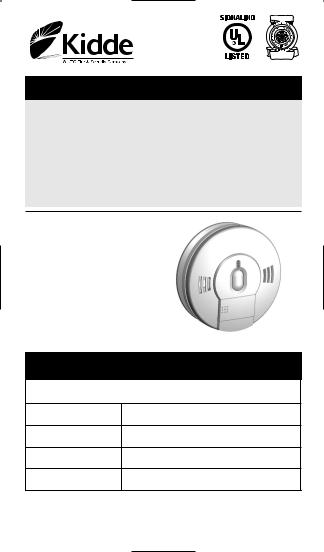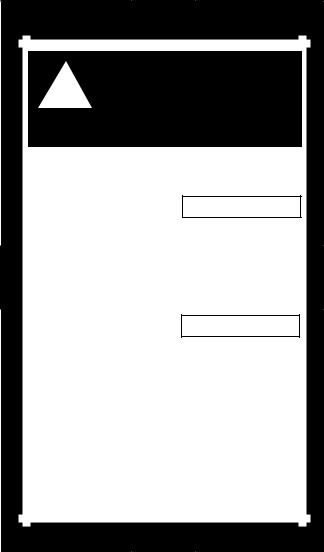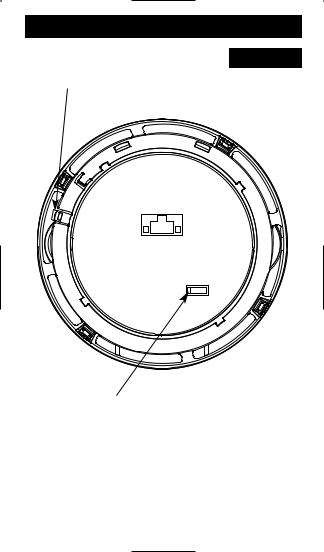Kidde KN-COPE-D User Manual

User’s Guide for Model KN-COPE-D
Combination
Photoelectric
Smoke and Carbon
MonoxideAlarm
•Battery Operation: 9V Battery
•2-LED Display
•Front Load Battery
•Peak Level Memory
•Hush ®
•Voice Message System
For questions concerning your Smoke and Carbon Monoxide Alarm, please call our Consumer Hotline at 1-800-880-6788.
For your convenience, write down the following information. If you call our consumer hotline, these are the first questions you will be asked:
Alarm Model Number
(located on back of the alarm):
Date of Manufacture
(located on back of the alarm):
Date of Purchase:
Where Purchased:
ATTENTION: Please take a few minutes to thoroughly read this user’s guide which should be saved for future reference and passed on to any subsequent owner.
Manual P/N 2540-7202-02


What To Do When The Alarm Sounds!
WARNING:
!Actuation of your CO Alarm indicates the presence of Carbon Monoxide (CO) which can kill you.
When the carbon monoxide alarm sounds:
If alarm signal sounds:
1)Operate the test/reset button
2)Call your emergency services (Fire Dept. or 911)
PHONE NUMBER
3)Immediately move to fresh air - outdoors or by an open door/window. Do a head count to check that all persons are accounted for. Do not reenter the premises nor move away from the open door/ window until the emergency services responders have arrived, the premises has been aired out, and your alarm remains in its normal condition.
4)After following steps 1-3,
if your alarm reactivates within a 24 hour period, repeat steps 1-3 and call
a qualified appliance technician to investigate for sources of CO from fuel burning equipment and appliances, and inspect for proper operation of this equipment. If problems are identified dur ing this inspection have the equipment serviced immediately.Note any combustion equipment not inspected by the technician and consult the manu facturer’s instructions, or contact the manufactur
er’s directly, for more information about CO safety and this equipment. Make sure that motor vehi cles are not, and have not been, operating in an attached garage or adjacent to the residence.

What To Do When The Alarm Sounds!
NEVER IGNORE THE SOUND OF THE ALARM!
Determining what type of alarm has sounded is easy with your Kidde Combination Smoke/CO Alarm. The voice message warning system will inform you of the type of situation occurring. Refer to the Features section on page 4 for a detailed description of each alarm pattern.
When the smoke alarm sounds:
Smoke alarms are designed to minimize false alarms. Cigarette smoke will not normally set off the alarm, unless the smoke is blown directly into the alarm. This unit contains nuisance alarm protection, which will reduce the impact of cooking particles. However, large quantities of combustible particles from spills or broiling could still cause the unit to alarm. Careful location of the unit away from the kitchen area will give the maximum nuisance alarm protection. Combustion particles from cooking may set off the alarm if located too close to the cooking area. Large quantities of combustible particles are generated from spills or when broiling. Using the fan on a range hood which vents to the outside (nonrecirculating type) will also help remove these combustible products from the kitchen.
If the alarm sounds, check for fires first. If a fire is discovered follow these steps. Become thoroughly familiar with these items, and review with all family members!
•Alert small children in the home. Children sleep very sound and may not be awakened by the sound of the smoke alarms.
•Leave immediately using one of your planned escape routes (see page 25). Every second counts, don’t stop to get dressed or pick up valuables.
•Before opening inside doors look for smoke seeping in around the edges, and feel with the back of your hand If the door is hot use your second exit. If you feel it’s safe, open the door very slowly and be prepared to close immediately if smoke and heat rush in.
•If the escape route requires you to go through smoke, crawl low under the smoke where the air is clearer.

What To Do When The Alarm Sounds!
•Go to your predetermined meeting place. When two people have arrived one should leave to call 911 from a neighbor’s home, and the other should stay to perform a head count.
•Do not reenter under any circumstance until fire officials give the go ahead.
•There are situations where a smoke alarm may not be effective to protect against fire as noted by the NFPA and UL. For instance:
-Smoking in bed.
-Leaving children unsupervised.
-Cleaning with flammable liquids, such as gasoline.
-Fires where the victim is intimate with a flaming initiated fire; for example, when a person's clothes catch fire while cooking.
-Fires where the smoke is prevented from reaching the detector due to a closed door or other obstruction.
-Incendiary fires where the fire grows so rapidly that an occupant's egress is blocked even with properly located detectors.

Table of Contents |
|
Introduction . . . . . . . . . . . . . . . . . . . . . . . . . . . . . . |
1 |
Product View . . . . . . . . . . . . . . . . . . . . . . . . . . . . . . |
2 |
Features . . . . . . . . . . . . . . . . . . . . . . . . . . . . . . . . . . |
4 |
Operating/Installation Instructions |
|
Step 1: Installation Guide: |
|
A. Recommended Installation Locations . . . . . . |
8 |
B. Where Not to Install . . . . . . . . . . . . . . . . . . . |
10 |
Step 2: Mounting Instructions . . . . . . . . . . . . . . |
11 |
Step 3: Testing Alarm . . . . . . . . . . . . . . . . . . . . . . |
11 |
Features and Operating Instructions . . . . . . . . . . |
14 |
Battery Replacement . . . . . . . . . . . . . . . . . . . . . . . |
17 |
General Alarm Maintenance . . . . . . . . . . . . . . . . . |
18 |
Carbon Monoxide Safety Information |
|
General CO Information . . . . . . . . . . . . . . . . . . . . |
20 |
Possible Sources . . . . . . . . . . . . . . . . . . . . . . . . . . |
20 |
CO Safety Tips . . . . . . . . . . . . . . . . . . . . . . . . . . . |
21 |
Symptoms of CO Poisoning . . . . . . . . . . . . . . . . . . |
21 |
Fire Safety Information |
|
Escape Plan . . . . . . . . . . . . . . . . . . . . . . . . . . . . . . |
22 |
Fire Prevention . . . . . . . . . . . . . . . . . . . . . . . . . . . . |
22 |
Industry Safety Standards |
|
National Fire Protection Association . . . . . . . . . . . . |
23 |
California State Fire Marshall . . . . . . . . . . . . . . . . . |
23 |
Consumer Product Safety Commission . . . . . . . . . |
24 |
Warranty and Service Information . . . . . . . . . . . . |
25 |

Introduction
Thank you for purchasing the Kidde Combination Photoelectric Smoke and Carbon Monoxide Alarm model KN-COPE-D.
Please take a few minutes to thoroughly read this user’s guide which should be saved for future reference. Teach children how to respond to the alarms, and they should never play with the unit.
Your Kidde Smoke/CO Alarm was designed to detect both smoke and carbon monoxide from any source of combustion in a residential environment. It is not designed for use in a recreational vehicle (RV) or boat.
If you have any questions about the operation or installation of your alarm, please call our toll free Consumer Hotline at 1 800-880-6788.
The guide on page 8 will help you determine the correct location of safety products that will help keep your home a safer place.
1

Product View
FRONT
Test/Reset/Hush |
Green& Red LED |
Button |
(Light Emitting Diode) |
Alarm Sounder |
Voice Speaker |
Battery Compartment
2

Product View
Mounting Bracket
Tamper Resist
Latch
BACK
Battery Door
Tamper-Resist
Slide
3

Features
•Permanent independent smoke and carbon monoxide sensors.
•Smoke alarm takes precedence when both smoke and carbon monoxide are present.
•Alarm/Voice message warning system that alerts you of the following conditions in the manner described below, thus eliminating any confusion over which alarm is sounding:
o FIRE: The alarm/voice pattern is three long alarm beeps followed by the verbal warning message “FIRE! FIRE!”. This pattern is repeated until the smoke is eliminated. The red LED light will flash while in alarm/voice mode.
o CARBON MONOXIDE: The alarm/voice pattern is four short alarm beeps followed by the verbal warning message “WARNING! CARBON MONOXIDE!”. After four minutes the alarm/voice pattern will sound once every minute until the unit is reset, or the CO eliminated. The red LED light will flash while in alarm/voice mode.
o LOW BATTERY: When the batteries are low and need replacing the red LED light will flash and the unit will “chirp” one time, followed by the warning message “LOW BATTERY”. This cycle will occur once every minute for the first hour. After the first hour the red LED light will continue to flash every minute accompanied by the “chirp” only sound. The voice message “LOW BATTERY” will sound once every fifteen minutes during the “chirp” only cycle. This will continue for at least seven days.
•Voice Message System that alerts user to the following conditions:
o System announces “HUSH MODE ACTIVATED” when the unit is first put into HUSH Mode.
o System announces “HUSH MODE CANCELLED” when unit resumes normal operation after Hush Mode has been cancelled.
o System announces “CARBON MONOXIDE PREVIOUSLY DETECTED” when the unit has detected CO concentrations of 100 ppm or higher.
o System announces “PUSH TEST BUTTON” when the unit is powered up, reminding user to activate the Test Button.
•One “chirp” every 30 seconds is an indication that the alarm is malfunctioning. If this occurs call the Consumer Hotline at
4 1-800-880-6788.
